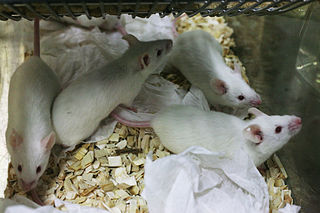Gut Bacteria and Obesity
Subject areas: Microbiology, Physiology
Vocabulary:
germ-free mice – More specifically, axenic (completely free of microorganisms in the gut and otherwise) and gnotobiotic (gnotos = known, bios = life, so these have specific populations of bacteria inoculated into them but no others). These mice must be delivered by cesarian section to avoid contamination through vaginal birth, and then raised in individual isolator cages. There are only a few facilities in the country that house and maintain axenic and gnotobiotic mice.
The article: Ridaura, V.K. et al, Science 341, 1241214 (2013). doi: 10.1126/science.1241214
The importance of gut bacteria to the overall health of humans (and other animals) has been highlighted in the last couple of years. Fecal transplants have been used to treat otherwise untreatable Clostridium dificile infections, and have been demonstrated to increase insulin sensitivity in some patients with metabolic syndrome. Changes in the populations of different gut bacteria have been linked to obesity in a number of studies, but this article actually demonstrates that changing the gut bacteria can also change the weight status of an animal.
What did they do?
The basic setup is fairly simple. Germ-free mice are inoculated with fecal samples from either a healthy-weight person or an obese person. For this study, the researchers used four pairs of twin women in the 21-32 age range: one of each pair was obese, and the other who was not. At first, all mice were given unlimited, sterile, and identical food. At 15 days after treatment, the mice with gut bacteria from a healthy-weight twin did not change significantly in mass, but the mice with gut bacteria from an obese twin had gained significantly more fat and lean body mass, ~10% increase in fat mass. This is good support for the hypothesis that the composition of gut bacteria can affect body morphology.
Adding an interesting twist to further evidence for this idea, the researchers co-housed the obese and lean mice to allow for bacterial transfer. Mice normally ingest fecal matter, so this provided natural sharing of gut microbes between the two mice populations. What they found was somewhat surprising: it appeared that exposure of obese mice to bacterial populations from lean mice feces lowered their fat mass, but the reverse was not true! The lean mice did not show a significant increase in fat mass by being exposed to feces from obese mice.
The idea that fecal bacteria from lean mice are better at colonizing than those from obese bacteria is supported by experiments in which germ-free mice were co-housed with a lean-inoculated and an obese-inoculated mouse. The initially germ-free mice did not increase their fatty tissue.
So Which Bacteria are the Good Ones?
Although fecal transplants have been done for some human therapies, there are obvious drawbacks, the primary one being the danger of inoculating a patient with a pathogenic organism. For that reason, and to have more detailed knowledge about the interplay between the many bacterial species in the gut, the researchers tried to see if they could figure out exactly which bacteria were helping obese mice become leaner. They chose a group of 39 bacterial species that seemed to be linked to the features of the lean mice phenotype, and inoculated obese mice with them. Unfortunately, that did not show any change to the obese mice, suggesting that something more complex is going on within the fecal bacteria community.
Role of Diet
Most of the experiments were carried out with mice that were given food pellets that were low in fat and high in plant polysaccharides (carbohydrates and fiber). The experimenters also tried some of the experiments using food that was relatively high in fat and low in fruits and vegetables. Again, the mice treated with gut bacteria from the obese twin gained more fat tissue. However, this time, co-housing with lean-twin bacteria-treated mouse did not rescue the mouse from obesity. It appears that for the lean-twin bacteria to prevent obesity, the mouse had to be eating a healthy diet already.
Overall, this is a cool example of the interplay between vertebrates like us or mice, and the microbial communities that live on, and within, us. This certainly doesn’t mean that we are likely to use fecal transplants to treat obesity anytime soon, but it is certainly possible to begin thinking about the steps needed toward a therapeutic pill or suppository that contains only helpful bacteria.


No comments
Be the first one to leave a comment.